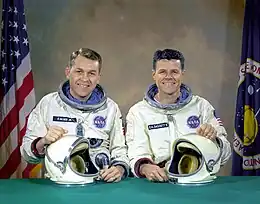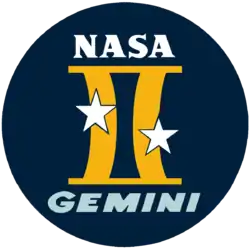1966 NASA T-38 crash
The 1966 NASA T-38 crash occurred when a NASA Northrop T-38 Talon crashed at Lambert Field in St. Louis, Missouri, on February 28, 1966, killing two Project Gemini astronauts, Elliot See and Charles Bassett. The aircraft, piloted by See, crashed into the McDonnell Aircraft building where their Gemini 9 spacecraft was being assembled. The weather was poor with rain, snow, fog, and low clouds. A NASA panel, headed by the Chief of the Astronaut Office, Alan Shepard, investigated the crash. While the panel considered possible medical issues or aircraft maintenance problems, in addition to the weather and air traffic control factors, the end verdict was that the crash was caused by pilot error.
 Astronauts Elliot See and Charles Bassett | |
| Accident | |
|---|---|
| Date | February 28, 1966, 8:58 am CST |
| Summary | Controlled flight into terrain due to pilot error |
| Site | McDonnell Aircraft Building 101, adjacent to Lambert Field, near St. Louis, Missouri, U.S. 38°45′14″N 90°20′42″W |
| Aircraft | |
| Aircraft type | Northrop T-38 Talon |
| Registration | NASA 901 |
| Flight origin | Ellington Air Force Base, Texas |
| Destination | Lambert Field, St. Louis, Missouri |
| Occupants | 2 |
| Passengers | 0 |
| Crew | 2 |
| Fatalities | 2 |
| Survivors | 0 |
In the aftermath of the crash, the backup crew of Thomas Stafford and Eugene Cernan were moved up to the primary position for the Gemini 9 mission, scheduled for early June. Jim Lovell and Buzz Aldrin, who had formerly been the backup crew for Gemini 10, became the mission's backup crew and through the normal rotation were assigned as prime crew for Gemini 12. Without the Gemini experience, it is unlikely that Aldrin would have been assigned to the Apollo 11 mission, during which he became the second person to walk on the Moon.
Accident
See and Bassett were the prime crew assigned to the Gemini 9 mission. They and the backup crew for the mission, Tom Stafford and Gene Cernan, were flying to St. Louis from their normal training base in Houston for two weeks of simulator training for rendezvous and docking procedures at McDonnell Aircraft, the prime contractor for the Gemini spacecraft. It was a routine flight that they had made many times previously.[1]
See and Bassett flew in one Northrop T-38A Talon jet trainer, tail number NASA 901 (Air Force serial number 63-8181), with See at the controls and Bassett in the rear seat. A second T-38, NASA 907, carried Stafford and Cernan in the same configuration. The two aircraft took off from Ellington Air Force Base in Texas at 7:35 a.m. CST, with See in the lead and Stafford in wing position.[2] Weather at Lambert Field in St. Louis was poor, with rain, snow, and fog, broken clouds at 800 ft (240 m) and a cloud ceiling of 1,500 ft (460 m), requiring an instrument approach. When the two aircraft emerged below the clouds shortly before 9 am, both pilots realized that they had missed the outer marker and overshot the runway.[3]
See then elected to perform a visual circling approach, a simplified landing procedure allowing flight under instrument rules, as long as the pilot can keep the airfield and any preceding aircraft in sight. The reported weather conditions at the airport were adequate for this type of approach, but visibility was irregular and deteriorating rapidly. Stafford began to follow See's plane, but when he lost sight of it in the clouds, he instead followed the standard procedure for a missed approach and pulled his aircraft up, back into the clouds for another attempt at an instrument landing.[4]
See completed a full circle to the left at an altitude of 500 to 600 ft (150 to 180 m), and announced his intention to land on the southwest runway (24).[1][4] With landing gear down and full flaps, the plane dropped quickly but too far left of the runway.[5][6] See turned on his afterburner to increase power while pulling up and turning hard right.[7] Seconds later, at 8:58 a.m. CST,[4] the plane struck the roof of McDonnell Building 101 on the northeast side of the airport. It lost its right wing and landing gear on impact, then cartwheeled and crashed in a parking lot beyond the building which was in use as a construction staging area.[7]
Both astronauts died instantly from trauma sustained in the crash. See was thrown clear of the cockpit and was found in the parking lot still strapped to his ejection seat with the parachute partially open. Bassett was decapitated on impact; his severed head was found later in the day in the rafters of the damaged assembly building.[8]
Inside Building 101, 17 McDonnell employees and contractors received mostly minor injuries from falling debris.[9][4] The crash set off several small fires inside the building,[9][10] and caused minor flooding from broken pipes and sprinklers.[1] See and Bassett died within 500 ft (150 m) of the spacecraft that they were to have flown in orbit, which was in the final stages of assembly in another part of Building 101.[5] Spacecraft S/C9 was undamaged, but a piece of debris from the T-38's wing struck the unfinished S/C10 spacecraft.[11]
Stafford and Cernan, still circling in the clouds in the second T-38, had no idea what had happened to their flight partners. Air traffic controllers were confused by the two planes in flight attempting different abort actions after the initial missed approach,[7] and no one on the ground knew who was in the crashed plane.[2] After some delay, Stafford and Cernan were asked to identify themselves and given permission to land, but they were not informed of the crash until on the ground.[11][12] Although personally distraught over the loss of his close colleagues and friends, Stafford acted as NASA's chief contact on the scene until other personnel arrived to relieve him later in the day.[13]
Investigation and aftermath
NASA immediately appointed a seven-member panel to investigate the crash, headed by their Chief of the Astronaut Office, Alan Shepard. While the panel weighed possible medical issues, aircraft maintenance problems, weather conditions, and air traffic control factors, their end verdict was pilot error, citing See's inability "to maintain visual reference for a landing" as the primary cause of the crash.[4] See was described as a "cautious and conservative" pilot in the accident report.[14] In his memoir, chief astronaut Deke Slayton was less diplomatic, calling See's piloting skills "old-womanish."[11][15][16] Others, including Neil Armstrong, who had worked with See on the backup crew for Gemini 5, have since defended See's piloting ability.[8][11]
Since the crash did not affect space flight operations and the spacecraft itself was undamaged—it was shipped to NASA two days after the crash—the accident caused neither delays nor engineering changes in the U.S. space program.[17] However, the loss of the Gemini 9 crew did cause NASA to reshuffle the crew assignments for subsequent Gemini and Apollo missions; Stafford and Cernan were moved up to the primary position for Gemini 9, re-designated Gemini 9A. Jim Lovell and Buzz Aldrin, who had formerly been the backup for Gemini 10, became the back-up crew for Gemini 9A, and through the normal rotation were then assigned as prime crew for the 1966's Gemini 12. Without experience during the Gemini mission, Buzz Aldrin would have been an unlikely choice for the 1969 Apollo 11 mission, during which he became the second man to walk on the Moon.[11]
Notes
- McMichael, W. Pate (May 2006). "Losing The Moon". St. Louis Magazine. St. Louis, MO. Archived from the original on March 19, 2014. Retrieved June 10, 2012.
- Freeze, Di (July 2005). "Gene Cernan: Always Shoot for the Moon, Part I". Airport Journals. Archived from the original on June 27, 2012. Retrieved June 10, 2012.
- Burgess, Doolan & Vis 2003, pp. 33–34.
- "Accident Board Reports Findings in See-Bassett Crash" (PDF). Space News Roundup. Vol. 5, no. 17. Manned Spacecraft Center, Houston, Texas: NASA. June 10, 1966. p. 3. Archived from the original (PDF) on March 5, 2016. Retrieved June 10, 2012.
- Rosenthal, Harry F. (March 1, 1966). "Cernan, Stafford Replace Spacemen Killed in Crash". Idaho State Journal. Pocatello, ID. Associated Press. p. 1. Archived from the original on February 28, 2022. Retrieved June 10, 2012.
- Hacker & Grimwood 1977, pp. 323–324.
- Burgess, Doolan & Vis 2003, p. 35.
- Evans, Ben (March 5, 2012). ""A Bad Call": The Accident Which Almost Lost Project Gemini". AmericaSpace. Archived from the original on September 30, 2020. Retrieved July 20, 2020.
- Burgess, Doolan & Vis 2003, p. 66.
- O'Neil, Tim (February 28, 2010). "A Look Back: Crash here killed two astronauts". St. Louis Post-Dispatch. St. Louis, MO. Archived from the original on August 30, 2012. Retrieved June 10, 2012.
- Evans 2009, pp. 308–309.
- Cernan & Davis 2000, p. 99.
- Burgess, Doolan & Vis 2003, pp. 68–69.
- Burgess, Doolan & Vis 2003, p. 73.
- Slayton & Cassutt 1994, p. 167.
- Cernan & Davis 2000, p. 96.
- Burgess, Doolan & Vis 2003, p. 70.
References
- Burgess, Colin; Doolan, Kate; Vis, Bert (2003). "Gemini Twins". Fallen Astronauts: Heroes Who Died Reaching for the Moon. Outward Odyssey: A People's History of Spaceflight. Lincoln and London: University of Nebraska Press. pp. 46–116. ISBN 978-0-8032-8509-5. LCCN 2015042585.
- Cernan, Eugene; Davis, Don (2000). The Last Man on the Moon: Astronaut Eugene Cernan and America's Race in Space. New York: St. Martin's Press. ISBN 978-0-312-26351-5. LCCN 98048206. OCLC 45049476.
- Evans, Ben (2009). Escaping the Bonds of Earth: The Fifties and the Sixties. Springer-Praxis books in space exploration. New York: Springer. ISBN 978-0-387-79093-0. LCCN 2009925769. OCLC 261924762.
- Hacker, Barton C.; Grimwood, James M. (1977). "Tragedy". On the Shoulders of Titans: A History of Project Gemini. NASA historical series. NASA Public Affairs Office. OCLC 44375394. NASA SP-4203. Archived from the original on May 2, 2012. Retrieved June 10, 2012.
- Slayton, Donald K. "Deke"; Cassutt, Michael (1994). Deke! U.S. Manned Space: From Mercury to the Shuttle (1st ed.). New York: Forge (St. Martin's Press). ISBN 978-0-312-85503-1. LCCN 94002463. OCLC 29845663.
External links
- Photos from the St. Louis Post-Dispatch Archived 2016-03-04 at the Wayback Machine
